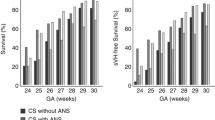Abstract
Objective
The aim of this study is to identify prenatal and perinatal risk and protective factors for the development of IVH, using a retrospective and case–control clinical study.
Methods
Prenatal and perinatal data were collected from three NICUs between January 2010 and December 2010. Univariate analysis was performed between case and control groups, and multivariate analysis was done to find out risk and protective factors for development of IVH. Further analysis of these variables was undertaken for gestational age strata <30, 30–34, and 35–37 weeks.
Results
By univariate analysis, factors related with IVH were C-section, prenatal steroid, pregnancy-induced hypertension, transport from other hospital, hypothermia, Apgar score at 1 and 5 min < 4, luminal, pathological jaundice, RDS, hypotension, volume expansion/inotropics, PO2, repeat suctioning, and mechanical ventilation (P < 0.05). Five variables remained significant in multivariate analysis. C-section and prenatal steroid use were protective variables while mechanical ventilation, hypotension, and transport from other hospital were risk factors. Further analysis of these variables was undertaken for gestational age strata <30, 30–34, and 35–37 weeks. Prenatal steroid use remained significant as a protective variable in gestational age less than 35 weeks; hypotension was shown to be a risk factor just in the time period between 30–34 weeks; transport from other hospital was a risk factor in gestational age more than 30 weeks; mechanical ventilation remained non-significant during the gestational age strata studied.
Conclusion
In the present study, factors that related to neonatal IVH included hypotension, prenatal steroid use, and transportation.
Similar content being viewed by others
References
McCrea HJ, Ment LR (2008) The diagnosis, management, and postnatal prevention of intraventricular hemorrhage in the preterm neonate. Clin Perinatol 35(4):777–792
Ment LR (2002) Practice parameter: neuroimaging of the neonate: report of the Quality Standards Subcommittee of the American Academy of Neurology and the Practice Committee of the Child Neurology Society. Neurology 58(12):1726–1738
Bassan H (2009) Intracranial hemorrhage in the preterm infant: understanding it, preventing it. Clin Perinatol 36(4):737–762
Ross G (1996) Specific cognitive abilities in 2-year-old children with subependymal and mild intraventricular hemorrhage. Brain Congnit 32:1–13
Mohamed MA, Aly H (2010) Transport of premature infants is associated with increased risk for intraventricular haemorrhage. Arch Dis Child Fetal Neonatal Ed 95:F403–F407
Laptook AR, Salhab W, Bhaskar B, Neonatal Research Network (2007) Admission temperature of low birth weight infants: predictors and associated morbidities. Pediatrics 119:e643–e649
Lee HC, Ho QT, Rhine WD (2008) A quality improvement project to improve admission temperatures in very low birth weight infants. J Perinatol 28:754–758
Subhedar NV, Shaw NJ (2003) Dopamine versus dobutamine for hypotensive preterm infants. Cochrane Database Syst Rev:CD001242
Shortland DB, Evans DH, Levene MI (1988) Blood pressure measurements in very low birth weight infants over the first week of life. J Perinatal Med 16:93–97
Hall RW, Kronsberg S, Barton BA, Kaiser JR, Anand K, the NEOPAIN Trial Investigators Group (2005) Morphine, hypotension, and adverse outcomes among preterm neonates: who's to blame? Secondary results from the NEOPAIN Trial. Pediatrics 115:1351–1359
Kluckow M (2005) Low systemic blood flow and pathophysiology of the preterm transitional circulation. Early Hum Dev 81:429–437
So KW, Fok TF, Ng PC, Wong WW, Cheung KL (1997) Randomised controlled trial of colloid or crystalloid in hypotensive preterm infants. Arch Dis Child Fetal Neonatal Ed 76:F43–F46
Greenough A, Cheeseman P, Kavvadia V, Dimitriou G, Morton M (2002) Colloid infusion in the perinatal period and abnormal neurodevelopmental outcome in very low birth weight infants. Eur J Pediatr 161:319–323
Al-Aweel I, Pursley DM, Rubin LP, Shah B, Weisberger S, Richardson DK (2001) Variations in prevalence of hypotension, hypertension, and vasopressor use in NICUs. J Perinatol 21:272–278
Graziani LJ, Spitzer AR, Mitchell DC, Merton MD, Stanley C (1992) Mechanical ventilation in preterm infants: neurosonographic and developmental studies. Pediatrics 90:515–522
Aly H, Hammad TA, Essers J, Wung JT (2012) Is mechanical ventilation associated with intraventricular hemorrhage in preterm infants? Brain Dev 34(3):201–205
Heuchan AM, Evans N, Henderson Smart DJ, Simpson JM, on behalf of the Australian and New Zealand Neonatal Network (2002) Perinatal risk factors for major intraventricular haemorrhage in the Australian and New Zealand Neonatal Network, 1995–97. Arch Dis Child Fetal Neonatal Ed 86:F86–F90
Shankaran S, Bauer CR, Bain R, Wright L, Zachary J, for the National Institute of Child Health and Human Development Neonatal Research Network (1996) Prenatal and perinatal risk and protective factors for neonatal intracranial hemorrhage. Arch Pediatr Adolesc Med 150:491–497
Merhar SL, Tabangin ME, Meinzen-Derr J, Schibler KR (2012) Grade and laterality of intraventricular haemorrhage to predict 18–22 month neurodevelopmental outcomes in extremely low birthweight infants. Acta Paediatr 101:414–418
Bell EF, Acarregui MJ (2008) Restricted versus liberal water intake for preventing morbidity and mortality in preterm infants. Cochrane Database of Systematic Reviews: CD000503
Thomas DB (1976) Hyperosmolality and intraventricular haemorrhage in premature babies. Acta Paediatr Scand 65:429–432
Author information
Authors and Affiliations
Corresponding author
Rights and permissions
About this article
Cite this article
Rong, Z., Liu, H., Xia, S. et al. Risk and protective factors of intraventricular hemorrhage in preterm babies in Wuhan, China. Childs Nerv Syst 28, 2077–2084 (2012). https://doi.org/10.1007/s00381-012-1875-9
Received:
Accepted:
Published:
Issue Date:
DOI: https://doi.org/10.1007/s00381-012-1875-9



